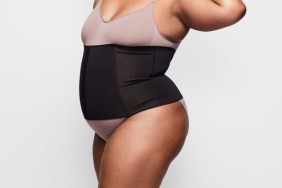But how safe is so-called “waist training,” where women squeeze themselves into a restrictive garment to achieve the much sought-after hourglass shape? And does waist training work? We recently caught up with some experts to find out. Here are the top 10 facts you need to know before you find yourself in a bind.
1. Women have been waist training for centuries, but thanks to celebs, the trend is back in a big way.
Corsets in their modern form have been around as early as the 1500s, but it wasn’t until the 19th century that the undergarment became the quintessential way to obtain a tiny waist and shapely hips. “The hourglass shape was a prominent aesthetic feature in the 1800s,” explains Dr. Raffi Hovsepian, a Beverly Hills plastic surgeon.
And we’ve seen corsets not only take over celebrity Instagrams (we’re looking at you, Kim), but also on the catwalk. During Fashion Month, we counted plenty — both Victorian-esque and modern corsetry — from Sarah Burton’s Marie Antoinette-inspired collection at Alexander McQueen to Riccardo Tisci’s homage to Victorian eroticism at Givenchy. And of course, there’s Disney’s new megahit Cinderella, which recruited the genius of costume designer Sandy Powell to create a dreamy, Victorian-inspired look to the film, using a strong corset to shape Lily’s already waifish waist.
2. But these ain’t your great-grandma’s girdles.
Corsets are a lot safer now than they were in Victorian times, says Hovsepian. “They were using cloth with steel bars or even whalebone to compress tissue,” he explains. Now, these garments are decidedly 21st century and made out of latex or cloth, but those nostalgic for the rib-crunching corsets of old can score at a place like Frederick’s of Hollywood or any number of traditional corset shops around the country.

Waist Trainer from Hourglass Angel
3. They’re safe…sort of.
Many women use corsets to achieve a thinner midsection or to help them recover after giving birth. But there are some risks, including putting extra pressure on your stomach, intestines and your colon, according to Dr. Gina Sam, an assistant professor of medicine and gastroenterology at the Icahn School of Medicine at Mount Sinai. “It can also cause abdominal discomfort and heartburn if the pressure is extremely tight,” she says.
And that’s not all — if not worn properly (read: Too tight! Too small!), corset-wearers risk fractured ribs, organ damage, urinary issues and decreased kidney function, according to Hovsepian.
4. They work…sort of.
Corsets work by nipping and tucking your waist with a structured support — and through temporarily dehydrating the tissue underneath, according to Hovsepian. The catch-22? “It’s not a permanent thing,” Hovsepian says. “Patients dehydrate further when they waist train, their skin looks dehydrated. It’s a very temporary thing.” Translation? Take off the corset, and your body will eventually revert back to its normal shape.
5. But not when you work out.
According to Sam, there’s no scientific evidence to back the claim of waist training — that is, wearing a corset while working out to get trim. “The key to losing weight is exercising daily and eating a healthy diet,” she says.
6. They won’t train your tummy, but they will help your posture.
Sorry, ladies — corset training also won’t magically give you a six-pack. What it will give you is better posture, courtesy of the tight fit. The structure of the garment won’t let you slouch, but it isn’t sculpting your core muscles.
7. Beauty is really only skin deep, so don’t always believe what you see.
As a Beverly Hills plastic surgeon, Hovsepian is a pro at helping patients achieve their goals of changing the way they look, from a more regal nose to slimmer thighs. But there’s some changing he can’t get behind. He says he’s had some patients get liposuction, then claim on Instagram that it was the waist trainer that helped. “That’s the irony of social media,” he says. “It’s hard to tell what’s real and what’s not. Social media is the new biggest bully.”
8. Waist training doesn’t interfere with baby-making…
A recent article earnestly questioned if Kim’s obsession with waist training was affecting her chances of getting pregnant again. But doctors say that’s not the case. “Corset training doesn’t have any effect on a woman’s ability to conceive,” Sam says.
9. …and it can help a mother’s postpartum body.
A few years ago, Jessica Alba professed her love of corset training, saying she slept in her garment after giving birth to get her enviable figure back. And yes, while a corset worn a few hours a day post-baby can help new moms bounce back, it should only be worn the first month after giving birth. “It’s beneficial for about the first three weeks to get the skin to retract back,” Hovsepian says.
10. You should treat your corset like you treat your Spanx.
But Hovsepian says it’s important to be realistic and to treat a corset as you would a pair of Spanx — that is, don’t wear them all day, every day. He recommends two hours at a time and a maximum of four hours per day. “Just because corsets are getting more comfortable doesn’t mean you should wear them all the time,” he says. Best to break them out for special events, when you need a little extra oomph.





